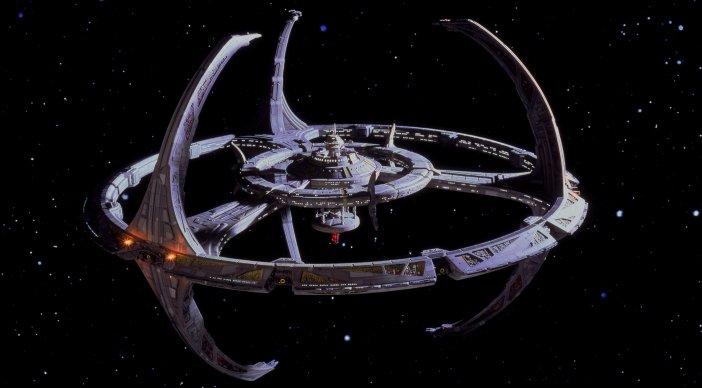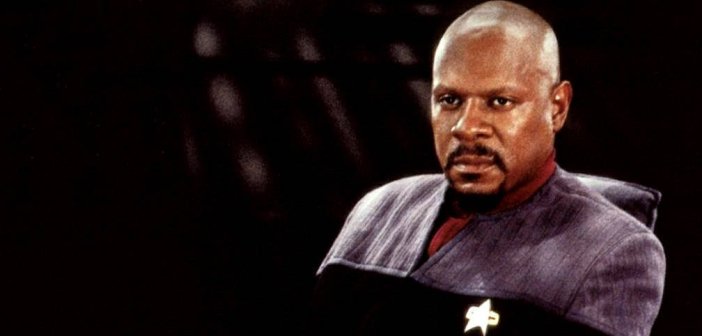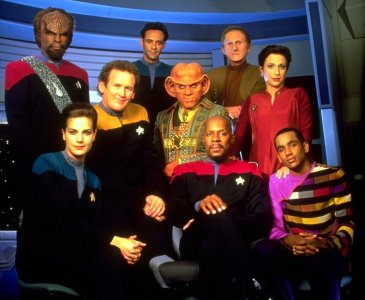Of All the Star Trek Series – Deep Space Nine is the One to Binge Watch
Growing up, the book I consulted most was the Radio Times guide to Star Trek, published to celebrate the 30th anniversary of the franchise’s launch. The Next Generation had just stepped into movie territory, while Deep Space Nine and Voyager were mid-run. The episode guides were my favourite: trivia and analysis of the kind that’s now ridiculously easy to find on TV Tropes or Memory Alpha. But in a pre-IMDB world, that was the guide you consulted if you wanted to check out who that actor was and what other episode we’d seen them in, or to find out where we’d first encountered that character, or to confirm that so-and-so was really related to a main cast member.
This year marks the 50th year of Star Trek, which means I’ve spent more than twenty years boldly going (and infinitive-splitting) where no one has gone before. Admittedly, the last few years have mostly involved sighing, “Oh, JJ, why so much time travel and lens flare?”, but there’s also the glory of binge-watching. I would say thank you Netflix, but I have always binge-watched Star Trek; my mom recorded and carefully labelled episodes when they first aired and so when I got sucked in there were shelves of VHS tapes ready to dive into. But now with streaming, it’s possible to binge on Star Trek without owning seven clunky collector’s edition sets.

And the Trek you want to binge on, as a modern viewer, is Deep Space Nine. Shh, shh, I know, I know. You think you want your Captain Picard, the mighty Patrick Stewart delivering impassioned speeches. You think you want to chuckle at Captain Kirk falling in love with the hot alien babe of the week (never mind that once you actually sit down with the series you realise it happens far less frequently than cultural osmosis suggests). You think you want Janeway, because, hey, a woman in the captain’s chair, finally! (You don’t want Enterprise. No one wants Enterprise.)
Oh modern viewers, attuned to plot arcs and hyperconscious of continuity errors, fond of morally ambiguous characters instead of out-and-out heroes, you want Deep Space Nine. You don’t quite believe that humanity is great and noble and always does the right thing. You don’t quite believe that people in a utopian society are that relatable. You want shadows and murkiness. You want conflict.
You want a show that, despite a fairly wobbly first season, nevertheless kicks off with a bang and a kick in the shins to its sister show, The Next Generation. It’s all very well that Locutus of Borg was rescued by the Enterprise and restored to Captain Picard, but the atrocities he commits – which are, with the exception of the First Contact movie, largely glossed over – leave others haunted. Benjamin Sisko loses his wife, Jennifer, and three years later, raising his son alone, he’s not impressed that it’s Picard he must deal with as he begins his new role as a station commander.

Picard is the bad guy here. Except he’s not quite: there are few out-and-out villains in DS9-land. The second-in-command, Kira Nerys, is a former terrorist, who actually uses the word ‘terrorist’ (can you spot that this is a pre-9/11 show?) and offers up some hard truths about what it means to live under military occupation, and the civilians that suffer on the path to a society’s freedom. The security chief has a dark past of his own; a shape-shifter whose race turn out to be leaders of an anti-Federation-esque group of planets who want to control (or perhaps destroy) the Alpha Quadrant, Odo has let innocent men die on his watch. Resident bartender Quark oscillates between being an out-and-out rogue and a community leader; he is all kinds of shades of grey.
Speaking of grey (skin), we have the Cardassians: one of the most complex races ever to grace the Star Trek universe. They are occupiers and yet haunted by it, as we see in a gorgeous season 1 episode; they are fiercely patriotic and sometimes blinded by it, as seen throughout the series. Dukat, the primary antagonist of the series, is both charismatic and repulsive; Garak, the ‘tailor’ with a mysterious past, intrigues us until the end; Damar, Dukat’s right-hand-man, undergoes the kind of character development unheard of in the 1990s for a guest star.
You want to binge watch this show because it doesn’t quite feel like the 1990s. When you watch Sisko living as a 1950s pulp sci-fi writer, the critique of racism is still disturbingly relevant; when a number of the crew inadvertently travel back in time to 2024 San Francisco and see what has been done to the city’s homeless individuals, it is scarily prescient.

When you watch Alexander Siddig portray Dr Julian Bashir, a character not defined by his Arab-ness, it is the sort of thing you wish happened more on television today. When Jadzia Dax, a member of a dual-identity species, falls in love with another woman and it is just a love story and not a great lesbian scandal, you wish we saw more of this on TV today. When the final eight/ten (depending on how you count) episodes of the final season all link together inextricably, it seems normal, now, not difficult. Not revolutionary.
DS9 did things in the 90s that we now take for granted. Ronald D Moore, who later went on to reboot Battlestar Galactica in the 00s, deserves much credit; apart from all the Klingon episodes he did much, along with Michael Pillar and Ira Steven Behr, to muddy the waters of Star Trek. There’s moral ambiguity here: while we know Picard was always right, Sisko and his crew were frequently in contentious territory. Is it okay to make a planet uninhabitable to prove a point to terrorists? Is it okay to lie, cheat and be an accessory to murder for the greater good? Is genocide ever acceptable? There are no easy answers here: the world Sisko and his crew inhabit is a cruel one, where bad things happen and bad humans (or humanoids) exist.
The Trek series you want to binge on, as a modern viewer, is DS9. The original Star Trek, though charming, is a tad too cheesy; The Next Generation is too episode/monster/alien-of-the-week to reward ongoing viewing. Voyager never fully takes advantage of its distress and resolves its dilemmas too quickly, and Enterprise… (okay, let’s just not count it). DS9 is a world where the things you do or say in season 3 come back to haunt you in season 5; where the plot points hinted at in season 1 haven’t been forgotten by season 6. Re-watching is rewarding – how else will a viewer understand that season 5’s ‘Things Past’ is a direct response to season 2’s ‘Necessary Evil’? And how will a newcomer to televisual conventions appreciate Odo’s Columbo-esque moves?
It has been fifty years since Star Trek began, and we have a new TV series beginning in 2017. But my heart is still with that much-under-appreciated show about a space station and its inhabitants, and everything it did with that, and in an era not entirely governed by network schedules I can only urge you: go watch the best Star Trek series there ever was. Because it’s pretty damn awesome.
Featured Image Source

